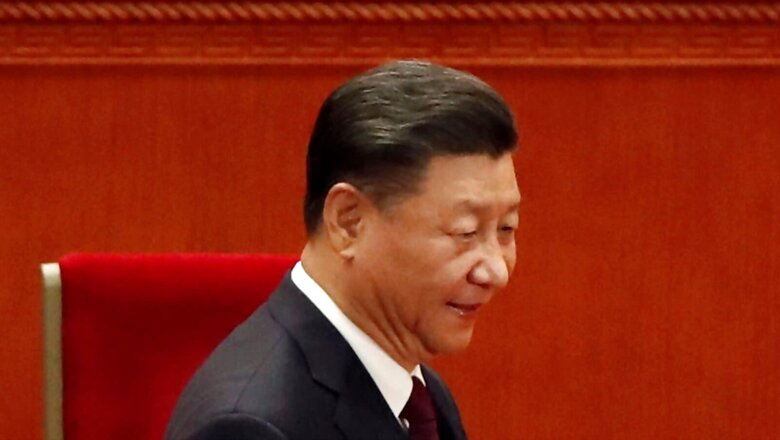
views
President Xi Jinping’s Tibet visit (he visited Nyingchi opposite Arunachal Pradesh and Lhasa) on July 20-21 has significance on many counts for the future of Tibet and India-China ties. The last time a ranking Chinese leader visited Tibet was Jiang Zemin in 1990 as General Secretary of the Chinese Communist Party. Xi’s visit is intended to send political signals to the Chinese public, the Tibetans and to India. His delegation included Zhang Youxia, vice-chairman of the Central Military Commission.
The negative signal to India is clear. Just as visits by our leaders to Arunachal Pradesh are seen by China as politically provocative, India has to take note of the implications of visits by China’s top leadership to Tibet and what that portends. We may have accepted Tibet as part of the People’s Republic of China, but as Tibet is the springboard for China’s persistent territorial claims on India, visits there are not akin to purely internal ones to other regions of China. Tibet is not China’s internal affair for us.
That Xi has decided to visit Tibet when China is involved in a military confrontation with India has special connotations. If he had visited Tibet after a resolution of the crisis and a restoration of the ground positions that existed in April 2020, the political nuance would be less troubling. With negotiations on restoring the status quo ante stalemated, and setting the new terms of border management an uncertain exercise, which, in turn, carries serious implications with regard to our future security challenges, Xi’s visit suggests a hardened Chinese position on the border issue under his sanction.
China’s Deceptive Talk on Tibet
It is ironical that when Xi took power the venerable Dalai Lama had hopes, based on his positive views of Xi’s father, that negotiations with China would move forward and that he could even envisage visiting China and his homeland. In reality, Xi’s policies towards Tibet have been notably hardline, with China strengthening its military hold over the region, exploiting its resources without regard to the environment, building dams on the Brahmaputra (11 already), with a projected dam at the river’s bend before it enters India which will be the world’s largest. China is criss-crossing Tibet’s pristine and fragile landscape with roads and railway lines for both military and economic reasons, accelerating demographic changes, including with the settlement of Hans in newly built villages close to India’s border in the east.
Xi has given a call to integrate Tibet more closely with China, Sinicise and socialise it (at the 7th Tibet Forum Meeting of the Chinese parliament at the National People’s Congress on August 29 last year), impose Mandarin at the cost of the Tibetan language, which would mean the progressive erosion of Tibetan culture. Xi’s policies are totally counter to Dalai Lama’s position on a genuinely autonomous Tibet as part of China.
ALSO READ | Sent to Construction Camp Not School, Forced to Testify against Parents: A Child’s Life in Tibet in 1960s
Xi’s intentions towards Tibet do not seem to have been adequately taken note of. On March 9, 2013, he said: “To govern the country well we must first govern the frontiers well, and to govern the frontiers well we must first ensure stability in Tibet.” Why Xi should speak about his concerns for China’s frontiers when no one is threatening them is typical of China’s deceptive talk. China has settled its frontiers with Russia and contiguous Central Asian states; it has illegally acquired Indian territory in Shaksgam valley. Actually, China is threatening the frontiers of others, be it land and maritime, by extending its own territorial claims arbitrarily in violation of agreements and international law, be it in South and East China Seas, Bhutan or India.
The reference to stability in Tibet through governing its frontiers well makes no sense as the cause of instability is China’s military occupation of Tibet, destruction of its autonomy, the castigation of the Dalai Lama, interference in the practice of Tibetan Buddhism, Tibetan resistance to Chinese rule suppressed through a system of internal surveillance, tight control over communication, demographic changes and so on.
India is not threatening Tibet’s security through border claims, military action or promotion of unrest there. The Dalai Lama is wedded to non-violence. The entire exercise of border management, with a string of confidence building agreements, is defensive from India’s point of view. Efforts to improve our border infrastructure is not to encroach into Tibet but to counter Chinese at-will provocations. The latest Chinese aggression in Ladakh is not about China’s frontier governance (makes no sense anyway in the vast uninhabited frozen territory in Ladakh) or stability in Tibet but is intended to politically and militarily browbeat India for larger geopolitical reasons.
Creating Pockets of Division?
China’s relations with the US have seriously deteriorated and India’s ties with the US have greatly improved, with increasing military cooperation and joint stakes in the security of the Indo-Pacific region. Any argument that China’s insecurity about Tibet is related to these developments would be fallacious. The US has not campaigned for the issue of human rights in Tibet as vociferously as in the case of Xinjiang. The issue of Tibetan rights also includes the reincarnation of the Dalai Lama according to Tibetan religious traditions. But in either case the US is not questioning China’s sovereignty over Tibet or Xinjiang. The US remains wedded to the One China policy. While the US recognises the McMahon Line, it has taken no position on the India-China territorial differences in Ladakh. It is possible that China’s insecurities about Tibet arise from its own understanding of the ground situation there.
On May 2021, China issued a white paper on Tibet—“Tibet since 1951: Liberation, Development and Prosperity”, which dealt with the development of the border areas with emphasis on security. The attention paid personally by Xi to border security in Tibet is reflected in the letter he wrote in 2017 to a Tibetan herdsman family in Lhunze County close to Arunachal Pradesh, asking it to set down roots to safeguard the Chinese territory and focus on developing their hometown. “Without the peace in the territory, there will be no peaceful lives for the millions of families,” Xi wrote.
ALSO READ | As CCP Turns 100, Xi Jinping Must Know That No Country Can Singlehandedly Take on the World
In 2017, the Plan of Tibet Autonomous Region on the Construction of Villages of Moderate Prosperity in Border Areas (2017-2020) was released. A 2019 report in the official TAR news portal had said the government had plans to build 624 “well off” villages and farms on Tibet’s borders. This seeming paranoia about securing Tibet’s border with Arunachal Pradesh when it is China that has claims beyond the McMahon Line, not India, can only be understood as a strategy to generate new pressures on India on the eastern front, aggravate a “two front threat” and stretch India’s resources.
The attempt also seems to be to create perceptions that India threatens Tibetan security and that the Tibetans should participate in defensive arrangements. The aim would be to create pockets of divisions amongst the Tibetans on their attitude towards India. This would explain reports that China has raised new militias comprising Tibetan youths and deployed them in the Chumbi Valley. These militias are small in number and reportedly separate from the Special Tibetan Army Unit raised by the PLA. China would have noted that India used its secretive Special Frontier Force comprising Tibetans to counter the Chinese forces in Ladakh during the stand-off, and this was made known publicly. China no doubt wants to counter this by creating its own Tibetan unit, if only for “psy-war” purposes.
All in all, Xi’s policies in Tibet are set to increasingly threaten our security, compel us to accelerate the building of our border infrastructure, boost our maritime capabilities as a counter to China’s threat on land and strengthen our partnerships with those countries that for their own reasons feel their interests are threatened by China’s aggressive and disruptive policies, while keeping the doors of dialogue at an equal level with China open.
The author is Former Foreign Secretary. He was India’s Ambassador to Turkey, Egypt, France and Russia. The views expressed in this article are those of the author and do not represent the stand of this publication.
Read all the Latest News, Breaking News and Coronavirus News here.

















Comments
0 comment